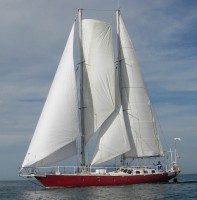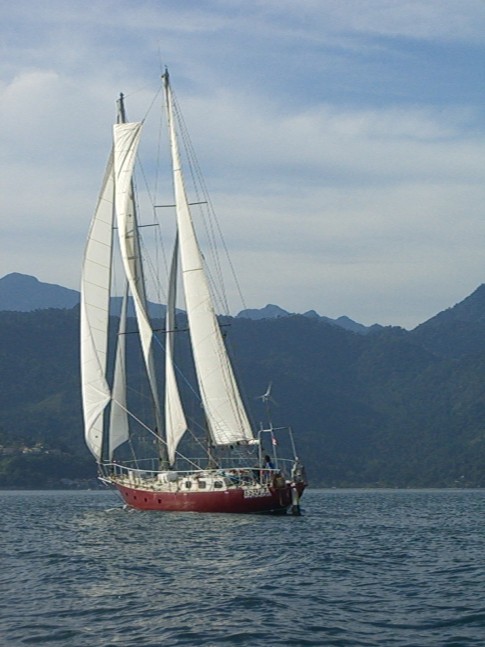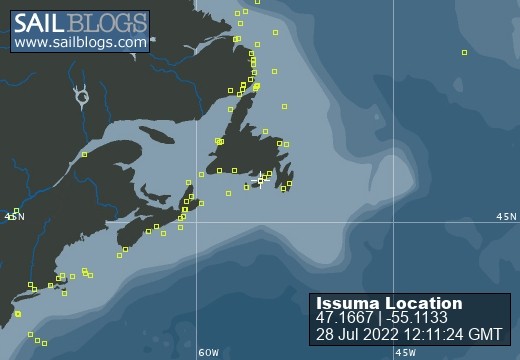
Issuma
28 July 2022
28 July 2022
08 May 2022
18 April 2022
07 April 2022
04 March 2022
17 February 2022 | Little Bay, Marystown, Newfoundland, Canada
16 February 2022
09 February 2022
06 February 2022 | Little Bay, Marystown, Newfoundland, Canada
05 February 2022 | Little Bay, Marystown, Newfoundland, Canada
01 February 2022 | Little Bay, Marystown, Newfoundland, Canada
30 January 2022 | Little Bay, Marystown, Newfoundland, Canada
25 January 2022 | Little Bay, Marystown, Newfoundland, Canada
24 January 2022 | Duricle Cove
17 January 2022
11 September 2021 | Little Bay, Marystown, Newfoundland, Canada
27 August 2021 | Grey River
26 August 2021 | Grand Bruit
26 July 2021 | Isle Valen
Battenless Mainsail
28 October 2015
Richard

Issuma has a generally well-built mainsail, made of polyester, reinforced with Spectra. The only problem with the mainsail is that it had battens.
I have cursed the battens many times as they jammed against the lazy jacks when raising or lowering the sail (they were usually better behaved when reefing). Every time I wanted to set the mainsail (which has the halyard and all reefing lines led to the cockpit), I had to climb up on the pilothouse and pull the sail back as I raised the first few metres to prevent the battens from getting caught. I had to do the same as it came down (a bigger problem, because it is very important to be able to get sails down quickly when a squall comes).
40,000 miles of sailing had stretched the sail, so that the halyard could not be tightened enough, because the sail was jamming into the halyard sheave. So I took the sail to Valparaiso, and asked Narci Sails to modify it. They moved the head (top corner) of the sail down, to make it shorter so it could again be fully raised. They added rings for a fourth set of reef points. They also cut back the roach (aft edge of the sail that curves outward, which needs to be supported by battens), removed the battens, and reinstalled new clew reefing rings (the old ones were cut away with the roach).
So now I have a mainsail that is a bit smaller. The mainsail can now be raised fully.
The dreaded battens are gone, so it raises and lowers easily, without cursing and climbing up and down to pull the sail free.
So far (several hundred miles), I've only used the fourth reef in conditions where I didn't really need it. The fourth reef seems like it will be a nice thing to have available when it is windy. Adding a fourth reef did seem to complicate the reeving of the clew reefing lines more than I expected, but after a while, I got them correctly led.
The slightly smaller size of the mainsail is only noticeable in winds of about 5-7 knots, when the jib overpowers the mainsail, and tries to turn the boat away from the wind a bit more than it did before.
UPDATE July 2016:
After sailing several thousand miles (Chile -> Antarctica -> Africa -> USA) with the battenless mainsail, I can say that it works really well. Raising and lowering the sail is definitely easier now with no annoying battens to snag lazy jacks.
The fourth reef has only been used a few times--notably as a riding sail, and when adding a bit of sail aft when going downwind in strong winds. The tack line for the fourth reef does have a tendency to get caught, but otherwise, there have been no problems with having installed the fourth reef.
I have cursed the battens many times as they jammed against the lazy jacks when raising or lowering the sail (they were usually better behaved when reefing). Every time I wanted to set the mainsail (which has the halyard and all reefing lines led to the cockpit), I had to climb up on the pilothouse and pull the sail back as I raised the first few metres to prevent the battens from getting caught. I had to do the same as it came down (a bigger problem, because it is very important to be able to get sails down quickly when a squall comes).
40,000 miles of sailing had stretched the sail, so that the halyard could not be tightened enough, because the sail was jamming into the halyard sheave. So I took the sail to Valparaiso, and asked Narci Sails to modify it. They moved the head (top corner) of the sail down, to make it shorter so it could again be fully raised. They added rings for a fourth set of reef points. They also cut back the roach (aft edge of the sail that curves outward, which needs to be supported by battens), removed the battens, and reinstalled new clew reefing rings (the old ones were cut away with the roach).
So now I have a mainsail that is a bit smaller. The mainsail can now be raised fully.
The dreaded battens are gone, so it raises and lowers easily, without cursing and climbing up and down to pull the sail free.
So far (several hundred miles), I've only used the fourth reef in conditions where I didn't really need it. The fourth reef seems like it will be a nice thing to have available when it is windy. Adding a fourth reef did seem to complicate the reeving of the clew reefing lines more than I expected, but after a while, I got them correctly led.
The slightly smaller size of the mainsail is only noticeable in winds of about 5-7 knots, when the jib overpowers the mainsail, and tries to turn the boat away from the wind a bit more than it did before.
UPDATE July 2016:
After sailing several thousand miles (Chile -> Antarctica -> Africa -> USA) with the battenless mainsail, I can say that it works really well. Raising and lowering the sail is definitely easier now with no annoying battens to snag lazy jacks.
The fourth reef has only been used a few times--notably as a riding sail, and when adding a bit of sail aft when going downwind in strong winds. The tack line for the fourth reef does have a tendency to get caught, but otherwise, there have been no problems with having installed the fourth reef.
Comments
| Vessel Name: | Issuma |
| Vessel Make/Model: | Damien II, 15m/50' steel staysail schooner with lifting keel |
| Extra: | Designed for Antarctica. Built in France by META in 1981. Draft 1.3m/4.5' with keel up, 3.2m/10.5' with keel down. More details at http://www.issuma.com/rhudson/issumaboat/IssumaDetails.htm |
| Home Page: | http://www.issuma.com/rhudson/ |
| Social: |



